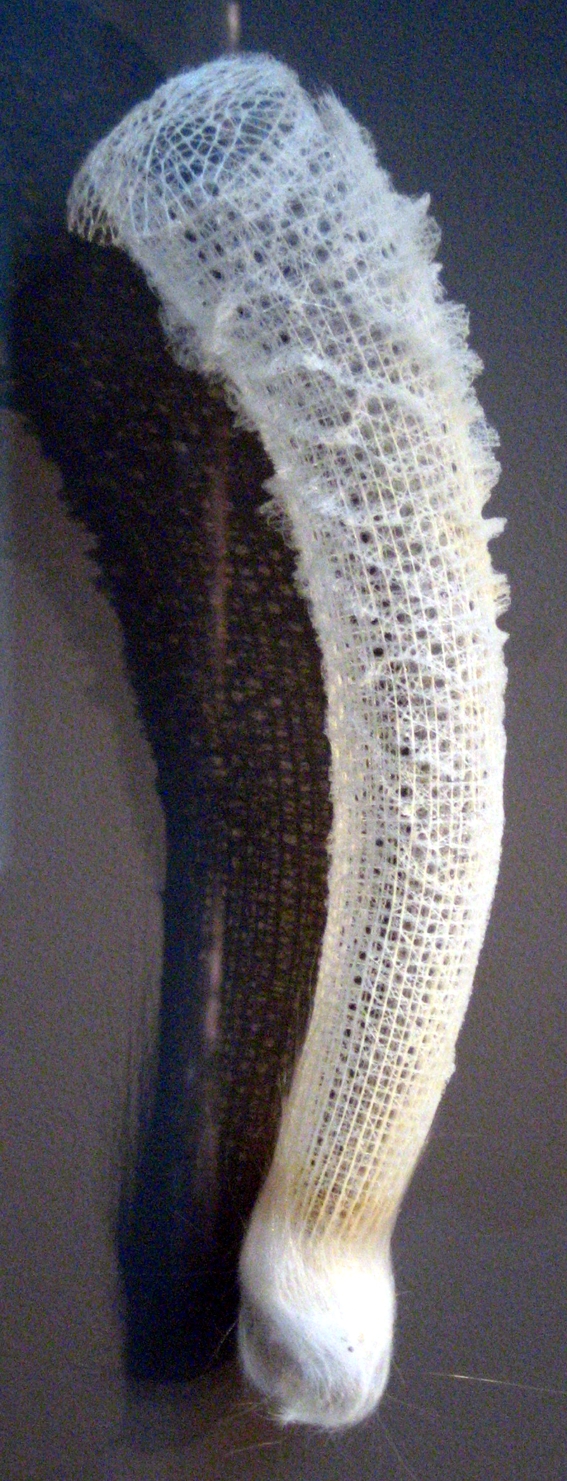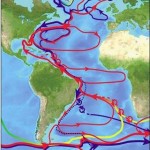#11 Euplectella sp (Phylum: Porifera, Class: Hexactenellida, Family: Euplectellidae)

[This Post is brought to you by Amanda Kahn a graduate student at Moss Landing Marine Labs with an inordinate fondness of sponges. You can catch her regular posts at the very cool MLML graduate student blog.}
Euplectella sponges mostly live on the abyssal plain – a flat, monotonous landscape of mud, mud, and more mud. Running transects across the abyssal plain is about as exciting as driving across Nevada…until you run across Euplectella. This sponge’s skeleton is made of tiny glass rods that are organized together into a framework rivaled by that of skyscrapers. That is pretty remarkable, considering that sponges don’t have brains… Some architects study sponge structures to try to figure out how to build stronger skyscrapers! The rods in the skeleton (called spicules) are special for another reason: they can conduct light, just like fiber optic cables. When we make fiber optic cables, we have to use really high temperatures and a lot of specialized conditions. When sponges make fiber optic cables, they use seawater. That’s it.
As if those reasons aren’t enough for Euplectella to make it in the top 27, this sponge has some resident shrimp species that call it home. Shrimps in the genus Spongicola move into Euplectella sponges once they are ready to mate, and are trapped inside of the sponge for the rest of their lives. In Japan, it was common to give Euplectella as a wedding gift, as a symbol of the two shrimp being united (or imprisoned, for you cynics out there) for the rest of their lives. For this romantic reason, Euplectella is also called Venus’s Flower Basket. *sigh*
Recap: Euplectella is awesome because it has no brain, but builds structures that are more complex than skyscrapers. It creates fiber optic cables better than we do, and it’s the deep sea’s symbol of love.
To see a picture of the shrimp inside of Euplectella, check out this website. Photo credits: Joanna Aizenberg, Bell Laboratories and Wikimedia Commons.

UPDATE: Amanda wrote up a some great answers to questions about sponges, including how they feed, if they have a sort of central nervous system and whether they have skin.
- #27: Brachiopods
- #26: Pig Butt Worm
- #25: Crawling Crinoids
- #24: Tube Worms
- #23: Dumbo Octopus
- #22: Xenophyophores
- #21: Phronima
- #20: Swimming Sea Cucumbers
- #19: Black Devil Anglerfish
- #18: Venus Fly-trap Anemone
- #17: Tripod fish, Bathypterois
- #16: Chaunax, the red-eyed gaper
- #15: Spookfish, Rhinochimaera pacifica
- #14: Alviniconcha hessleri, the hairy vent snail
- #13: Deep Sea Corals
- #12: Yeti Crab






Great visual comparison, Amanda. If we scaled up Spongicola sp. (refreshing!) to the size of these skyscrapers they would probably be 15ft tall or more.
The history of it being given as a gift in Japan made this an enjoyable read. And I concur with Peter on the visual comparisons to the skyscrapers.
This sponge’s skeleton is made of tiny glass rods that are organized together into a framework rivaled by that of skyscrapers. That is pretty remarkable, considering that sponges don’t have brains…
What? No, seriously, what was that you wrote?
You read correctly, sponges do not have brains, not much in the way of a nervous system either.
Yes, I know. I just don’t see how this is relevant. Most of nature doesn’t have a brain or much anything in terms of a nervous system.
Mmm-hmm. Like the jellies – heartless, brainless, spineless beasts.
But ever cool structural engineers none-the-less. Of course I am biting my tongue so I don’t make the wise-ass comment to ruffle all my engineering friends from BSU.
Nah, too good of a dig to pass…
See Bill, Drew et al. it really is a brainless job…
So it is a giant, really cool looking, shrimp capturing device- brilliant!
Sharky, true. Must be intelligent design ;)
…or perhaps it’s those shrimps, with their big evolved brains, that are manipulating the sponge into building fortifications….arrgghhhhhhhhhhhh
@Kevin Z
haa, you jest :) but the point I wanted to make was that nature exhibits numerous wonderfully complex shapes, structures and mechanisms. In this case, like many others, this is probably regulated by development and cell cycles. It’s not like this complexity emerges from organisms having to consciously think one day: “Hey, I think I’ll build myself a complex skeleton. Now, let’s see how I’ll go about this [goes to drawing board]”. Thus my earlyer comment: the fact that sponges don’t have a brain or nervous systems is irrelevant to this discussion.
Actually, I wake up in the morning and think about how to make complex skeletons. But I probably don’t represent the average american citizen perhaps? But yes, I agree with your point. Many of these patterns or processes are the result of biochemical, genetic and developmental pathways. I suppose the author’s intent though was to admire nature’s architecture, that which surpasses human intellect.
Listen not everybody who is going to read this post will automatically know that such architecture can be accomplished without intellect. ID is an all too familiar reminder of this. So I think Amanda’s comment was a simply reiteration of this point in bit of cheeky way.